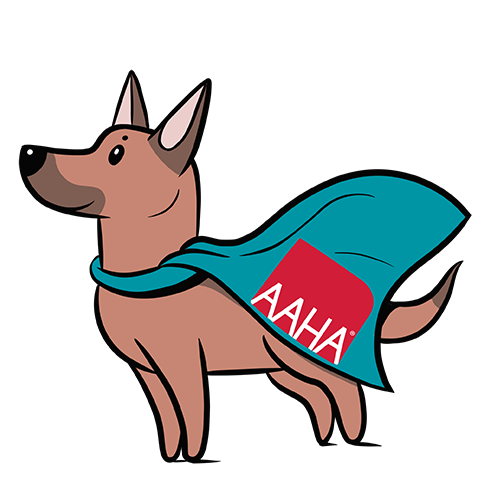
Who is Clark?
Clark is our mascot for the 2022 AAHA Canine Vaccination Guidelines, designed by artist Lili Chin. As a fully vaccinated pup, Clark represents the everyday superheroes who safeguard human and animal health by doing their part to stay protected.
Personalized Canine Vaccination Plans
What does “core for you” mean?
“Core” for an individual patient means giving the vaccines required for ALL dogs PLUS vaccines required based on the dog’s lifestyle and risk factors.
The 2022 AAHA Canine Vaccination Guidelines and associated resources help veterinarians design vaccination protocols based on the dog’s lifestyle and what they are at risk for. Vaccines that have historically been called “noncore” are just as essential as the vaccines that are required for all dogs. Ask, “What is core for this patient?” and create a personalized plan based on environment, risk, and your good clinical judgment.
What vaccines are required for all dogs?
All dogs should have the following vaccines:
- Distemper
- Adenovirus
- Parvovirus
- +/- Parainfluenza (often given in combination vaccines)
- Rabies
For more information, see Table 2: 2022 AAHA Core and Noncore Vaccines for Dogs
What other vaccines are required for dogs, based on lifestyle?
In addition to these, other vaccines are essential for some dogs based on their lifestyle and risk. These include:
- Leptospira (should be considered for all dogs based on increasing prevalence)
- Lyme disease
- Bordetella
- Canine influenza
- Rattlesnake toxoid
For more information, see Table 2: 2022 AAHA Core and Noncore Vaccines for Dogs
Should dogs be vaccinated for leptospirosis?
Most dogs in North America should be considered at risk of leptospirosis. Historically, the disease was most common in large-breed dogs with rural outdoor exposure. This is no longer true.
Small-breed dogs are frequently infected, perhaps because of urban and suburban exposure of dogs to wildlife reservoirs including rodents. Dogs of any age, breed, or sex can be infected.
Leptospirosis occurs throughout North America, and while often associated with exposure to water, infection is well documented in arid regions such as Arizona.
Risk factors for leptospirosis include:
- Dogs spending any time outdoors (including urban, suburban, and rural environments)
- Exposure to rodents
- Boarding in kennels or attending dog daycares
Should dogs be vaccinated for Lyme disease?
Vaccination for Lyme borreliosis should be considered for dogs that live within or travel to regions with emerging or endemic Lyme disease. Lyme disease is caused by infection with tick-transmitted borrelial pathogens. Although at least 21 species of borrelial pathogens can cause Lyme disease, in North America disease is due almost exclusively to Borrelia burgdorferi.
What’s the Risk of Lyme Disease in My State? Pet Disease Alerts Pet Parasite Forecast – Lyme Disease
Which bordetella vaccine is recommended?
All bordetella vaccinations work well. However, dogs that are at risk for bordetella are also at risk for canine parainfluenza virus and canine adenovirus-2, and combination IN bordetella and injectable core vaccines contain these antigens and are recommended by this task force.
Should dogs be vaccinated for canine influenza?
Routine use of canine influenza vaccines in all dogs is currently not recommended by the task force. Risk should be determined by current circulation of canine influenza virus and etiologic diagnosis using PCR in canine infectious upper respiratory disease (CIRD) cases.
Risk factors in individual dogs include:
- Boarding
- Dog daycare
- Dog parks
- Dog shows and agility events
- Travel
- Other instances where groups of dogs commingle
Track outbreaks of canine influenza in the United States here
If a dog or puppy is to be vaccinated with both a parenteral CAV-2 and an intranasal CAV-2, such as a core combo and a kennel cough combo, is it preferable to administer the vaccines simultaneously or separated by a time interval?
The short answer is we don't really know, as it has never really been formally addressed with current vaccines. Generally speaking, especially in the case of a primary vaccine series in puppies with variable amounts of passive immunity, it is preferable, immunologically, to start with IN (mucosal) delivery and follow-up a minimum of 10 days later with injectable vaccine. Whether or not administering both types of vaccines simultaneously would engender superior immunity may be dependent on previous immunological experience; it is unlikely to do harm, but veterinarians are encouraged to follow their best clinical judgement for the individual patient.
What about herd immunity?
Vaccines have mitigated the impact of infectious diseases on populations through herd immunity so successfully that some dog owners may hold the perception that vaccination is no longer necessary. Although individual dogs with low-risk lifestyles (i.e., minimal exposure to other animals) may benefit from herd immunity, unvaccinated individuals are still more vulnerable to infection, and reductions in population-level vaccination rates without eradication of the pathogen will inevitably result in a recurrence of disease at outbreak levels. This has been clearly demonstrated by recurrent canine distemper and parvovirus outbreaks in shelters, and by recent outbreaks of measles in human populations where reduced vaccine coverage exists. Thus, reliance on herd immunity is not a reason not to vaccinate, and vaccination is important to maintain herd immunity within populations.
Overdue Vaccines
The benefits of vaccination far outweigh the risks in cases of dogs with unknown immune status or vaccination history. In cases of overdue vaccines, consult specific vaccine manufacturers for instructions. A good rule of thumb is: When in doubt, vaccinate.
For more information, see Table 2: 2022 AAHA Core and Noncore Vaccines for Dogs
What About Titer Testing?
Routine titer testing to ascertain the necessity to revaccinate at currently recommended intervals is not usually advised, except for the following cases:
- Dogs have a history of adverse responses to vaccination
- There is a suspicion of vaccine-related autoimmune disease
- When owners express resistance or hesitancy to having their dogs vaccinated or boostered*
*If clients express hesitation or resistance to vaccination, communication and education about the importance of vaccines may help overcome this. See our Client Communication Resources for tips on talking to clients about vaccinations.
Vaccination Sites
Have vaccination site recommendations been stipulated for the dog as they have for the cat?
Vaccination guidelines for the dog do not specify injection-site recommendations. However, veterinarians are strongly encouraged to document the inoculation site and vaccine type in the patient’s medical record.
Should a disinfectant (e.g., alcohol) be applied to the injection site before administering a vaccine?
Because disinfectant might inactivate a modified-live virus (attenuated) product and is not known to provide any benefit to the patient, doing so is not generally recommended.
Adverse Vaccine Reactions
Should the volume of an individual dose of parenteral vaccine be reduced when vaccinating small breed dogs?
The volume recommended by the manufacturer generally represents the minimum immunizing dose; therefore, the total volume of a vaccine dose should always be administered. Arbitrarily reducing the volume of a vaccine may result in an immune response that is less than protective. Furthermore, there is no evidence that lowering the dose/volume of a vaccine will prevent an adverse event.
Administration of reduced dose volume of a rabies vaccine is “off-label” and may not be supported in state or local law.
If multiple vaccines are given at the same time, does this reduce or overwhelm the patient’s immune response?
Although antibody responses can vary after administration of different vaccines and antigens, there is no evidence of a lack of protective immunity following concurrent administration of multiple antigens or vaccines.
What causes adverse postvaccination reactions?
Adverse postvaccination reactions may be caused by:
- Inappropriate administration of a modified-live product
- Secondary to innate immune responses to the vaccine
- Specific cell-mediated or humoral immune responses to vaccine components
- Vaccine antigens that return to virulence (unlikely in appropriately tested and licensed vaccines)
Adverse reactions are genetically influenced in some cases, but breed is not a good indicator of whether a reaction will occur. Clients should be informed that adverse event risk occurs at the individual patient level.
How can I reduce the risk of an adverse postvaccination reaction?
Adverse event risk can be diminished by reducing the quantity of vaccine antigens presented to the patient’s immune system. In dogs, the antigens in vaccines that mostly cause reactions are proteins used in vaccine production like fetal calf serum, bovine serum albumin, gelatin, and casein.
Because the antigens of concern are not the label (or pathogen) antigens contained in the vaccine, combination vaccines containing multiple pathogens do not inherently carry more adverse event risk than single-component vaccines.
Because of the way rabies vaccine virus is propagated, single-component rabies vaccines may have more adverse event risk, as they have a more diverse array of proteins than combination vaccines containing other viruses that are propagated similarly, or other single-component vaccines.
Reducing antigenic stimuli can be achieved by reducing the number of vaccines administered at a single office visit. This is a particularly useful approach in small dogs.
Alternative vaccination schedules may be indicated, e.g., delaying administration of a noncore vaccine by 2 weeks following administration of core vaccines or by administering combination vaccines, since adverse reactions generally occur in response to proteins in the vaccines rather than the vaccine antigens.
When should a patient be premedicated with diphenhydramine prior to receiving a vaccine?
If the risk is hypothetical, i.e., involving an at-risk breed but in cases in which no previous reactions have occurred, pretreatment as a precaution is generally not recommended. Although prevaccination administration of diphenhydramine may prevent type I hypersensitivity reactions, the lack of any subsequent reaction does not actually prove the pretreatment was beneficial or necessary.
If the vaccination risk involves a dog with a history of previous vaccine reaction, one cannot presume reactions will automatically recur. Precautions such as limiting the number of vaccines administered are prudent, as is prevaccination administration of diphenhydramine.
Single anti-inflammatory doses of glucocorticoids, if administered, do not impair humoral responses to vaccination.
If the vaccination risk involves a patient with an existing immune-mediated disease, consideration should be given to the stability and condition of the patient, the need for vaccination, and prudent ways to minimize adverse event risk.
Vaccine Handling and Storage
How long can a reconstituted modified-live virus (MLV) vaccine remain at room temperature without losing activity?
At room temperature (e.g., 60°–80°F), some of the more sensitive MLV vaccines (especially CDV vaccine) may lose the ability to immunize within 2 to 3 hr following reconstitution. It is recommended that unused MLV vaccines be discarded 1 hr after reconstitution regardless of whether or not the product has been refrigerated.
Vaccine Overview and Types
What causes “vaccination failures?”
Vaccination failures, or the occurrence of disease in an animal that has received a vaccine against that disease, are rare but should be expected because no vaccine achieves 100% effectiveness.
Vaccination failures can occur for many reasons including:
- Failure of the vaccinated patient to mount an adequate immune response.
- Exposure to the infection before being fully vaccinated.
- Interference of maternal antibodies.
- Improper storage or handling of the vaccine, including inappropriate administration.
- Waning immunity (e.g., immunosenescence, or age-related deterioration of the immune system).
- Vaccine manufacturing errors, such as lack of potency due to instability, expiration, or improper storage.
Where do I report vaccination failures?
Vaccination failures should be promptly reported to the manufacturer. These reports are essential for detecting changes in product performance due to defects in particular lots of vaccines. In the United States, if a veterinarian is unable to report to the manufacturer, reports can be made directly to the United States Department of Agriculture (USDA) Center for Veterinary Biologics.
What are the four types of vaccines?
Canine vaccines are divided into four categories based on the physical type of immunizing antigen:
- Attenuated
- Inactivated
- Recombinant
- Toxoid
For more information, see Table 1: Categories of Canine Vaccines Based on Physical Type of Immunizing Antigen
Where can I get a list of licensed vaccines in the United States?
A list of licensed veterinary biologics is available at www.aphis.usda.gov/aphis/ourfocus/animalhealth/veterinary-biologics/ct_vb_licensed_products







